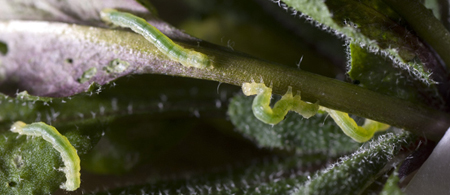Research: Project 2
Plant Anti-Insect Proteins
A central question in plant-insect interaction research concerns the identity of JA-regulated compounds that thwart the ability of herbivores to colonize, consume, or reproduce on plants. Although plant secondary metabolites have traditionally been viewed as the major determinants of host plant utilization by insects, proteins are also an important component of the plant’s defensive response. Wound-inducible proteinase inhibitors that impair digestive proteases in the insect gut provide one of the best examples of a defensive protein whose synthesis is tightly regulated by the JA pathway.
We are using proteomic analysis of insect gut content and feces (frass) to identify the plant's defensive protein arsenal. This novel approach is based on the premise that defensive proteins are relatively resistant to gut proteases and, as a consequence, are highly enriched during passage of the food bolus through the insect (Fig. 2). Application of this procedure to tomato-reared M. sexta larvae led to the identification of JA-regulated isoforms of arginase and threonine deaminase, which degrade the essential amino acids arginine and threonine, respectively, in the caterpillar gut. We hypothesize that arginase and threonine deaminase are components of a multitiered defensive system that functions to deplete the availability of essential amino acids in the insect gut. With funding from the USDA, we are using this proteomics platform to systemically identify anti-insect proteins from a broad range of crop plants. Results obtained from this research are expected to provide new tools to improve pest tolerance in crop plants.
